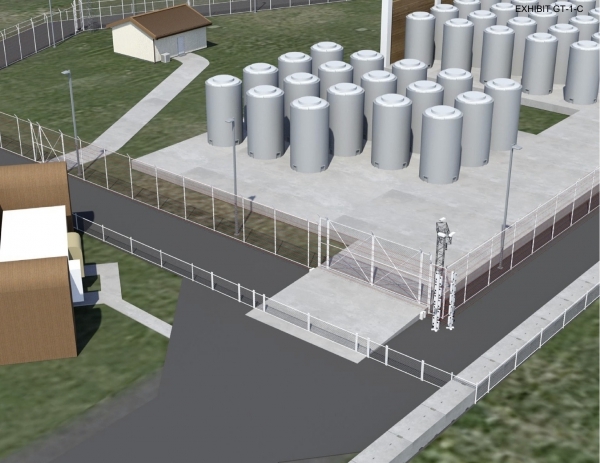VERNON — Entergy has requested permission to shrink Vermont Yankee's high-security “protected area” by nearly 90 percent, a move the company says will save at least $1.2 million per month.
The plan - which is under review by state and federal regulators - is to downsize the former nuclear plant's most secure zone from the current 10.5 acres to just 1.3 acres encompassing a spent fuel storage facility.
Though the change wouldn't take effect for more than a year, Entergy is asking the state Public Service Board for an expedited review: The company wants a decision by the end of August so that the security modification project can begin the following month.
“Reducing the size of the current protected area at VY station is a crucial part of the plant's decommissioning process,” George Thomas, a senior project manager at the Vernon plant, wrote in a memo submitted to the Public Service Board.
Entergy, which stopped power production at Vermont Yankee at the end of 2014, wants to accelerate the plant's decommissioning by selling the site to New York-based NorthStar Group Services. NorthStar has pledged to clean up most of the site by 2030, whereas Entergy's decommissioning plan could have taken up to 60 years.
Deadline: 2018
Entergy and NorthStar want to complete the sale by the end of 2018, but both the federal Nuclear Regulatory Commission and the state Public Service Board must first approve the deal.
The end of 2018 is important for another reason: That's the current deadline for moving all of Vermont Yankee's radioactive spent fuel from a cooling pool into more secure storage inside sealed dry casks.
That's a $143 million effort. The start of the fuel move has been delayed, but Entergy administrators say they expect it to begin soon.
Eventually, all of the spent fuel will be stashed in 58 casks standing on two concrete pads. And that fuel-storage area is the focus of Entergy's new modified-security proposal.
Vermont Yankee's current, 10.5-acre protected area - access to which is tightly controlled under 24-hour armed guard - encloses multiple structures including the turbine, reactor, and control room buildings.
The much smaller area to take effect in late 2018 would cover only the two fuel-storage pads and a new central alarm station building to be built as part of the proposed project.
To protect the spent fuel, crews also would install new security facilities including a concrete vehicle-barrier system; two fences with a paved “isolation zone” between them; and new lighting, cameras, and intrusion-detection equipment.
The project, while relatively small in scope, is supposed to have big benefits.
For one thing, the smaller security zone will allow decommissioning to “proceed in an efficient and orderly manner,” Entergy's attorney's wrote. Thomas noted that eliminating the larger protected area will allow decommissioning crews and vehicles to work “without the substantial burden and expense of having to enter and exit” that area.
Money is another factor. The reduced security zone will allow Entergy to reduce its expenditures from Vermont Yankee's decommissioning trust fund by about $1.2 million per month, administrators say.
That's because the smaller area “will require fewer security personnel to monitor and to maintain,” the company says. There also will be a reduced need for control room operators, technicians, and support staff.
Other savings?
The estimated savings include only personnel costs. It's possible that the secure-area downsizing also could result in reduced insurance, taxes, and utility bills, according to documents filed with the Public Service Board.
Those documents appeared June 5 on the board's electronic filing system website, known as ePSB. Officials said Entergy initially filed its request via hard copies in early May, and there had been a delay in posting them online.
Either way, Entergy is seeking a relatively quick turnaround by asking the board to rule on the request by the end of August. In his memo, Thomas noted that the company wants to get some important work done before next winter.
“The project will be conducted almost entirely outdoors, so it is weather-sensitive,” Thomas wrote. “If Entergy VY does not receive authorization by Aug. 31, it may not be able to complete the underground work in 2017, which would extend the installation schedule.”
An expedited Public Service Board approval process may be possible because Entergy has submitted its request as an amendment to a previous board decision.
The board last year authorized a second spent fuel pad at Vermont Yankee, and Entergy says the new modified-security proposal simply is an extension of that decision because it is “closely related” to the fuel pad case and also “is more modest in scope than the previously approved work.”
From an aesthetic standpoint, Harry Dodson - a Massachusetts landscape architect and an Entergy consultant - wrote that the security project “will add small new visual components to the site,” but “the changes are minor when considered against the visual backdrop of the far larger VY station industrial site.”
Furthermore, a reduced security zone “will result in a net reduction in visual impacts when the current larger protected area is removed during decommissioning,” Dodson wrote.
Entergy's proposed changes also are dependent on approval from the NRC.
The company has filed for a license amendment “to reduce the site's security plan once all of the Vermont Yankee spent nuclear fuel has been transferred to dry cask storage,” NRC spokesman Neil Sheehan said.
Such a request “is normal for all permanently shutdown nuclear power plants,” he said.
“We are currently reviewing the submittal and are targeting completing the licensing action within one year,” Sheehan added. “Again, it is not needed until all of the fuel is moved to [dry casks], something which won't happen until at least mid- to late 2018.”
